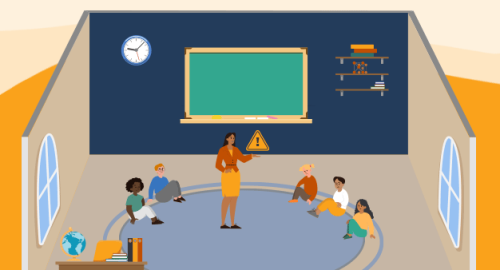Listen to this blog (6 mins)
“You could see the fear in these kids’ eyes,” Adam Coughran, co-founder of Safe Kids Inc., said of an active shooter threat he responded to at a California middle school. It was lunch, so everyone was scattered throughout the campus and teachers weren’t with their students.
As part of the Primary Response Officer Team, also known as the Active Shooter Team, in the police force, Adam was familiar with situations like these. It became evident, though, that the kids in the school weren’t equipped to keep themselves safe. “They didn’t know where to go. They didn’t know what to do,” Adam continued.
Talking about worst-case scenarios, active shooters, and other violent school threats is one of the hardest conversations to have with students, but it’s an important one. Students and staff must know how to keep themselves safe, and in worst-case scenarios, survive and remain calm. How can schools do this without increasing their anxiety or trauma?
To find out, continue reading the summary of our interview with Adam below. You can listen to his full interview on School Safety Today.
School Active Shooter Training Should be Age and Developmentally Appropriate
Active shooter training should include evidence-based, age-appropriate curriculum that gives teachers and students the confidence to respond to any kind of violence. The lessons should be teacher-led, interactive, adaptable, problem-based, and developed with school safety and mental health professionals to ensure each lesson is appropriate for the grade level. For example, using a fictional picture book to demonstrate how characters stay safe is appropriate for younger students, whereas collaborative, table-top exercises are appropriate for older students. It’s critical that schools also have lesson plans for students with disabilities.
The terminology you use matters, too. Consider how you would react if someone told you there is an armed assailant outside your door and you’re going to have to fight them. Fight is an aggressive word, and right off the bat, some people may disengage because they know they would never fight anyone. Using the word fight during school training also contradicts what schools teach (i.e., fighting is bad).
Students Should Feel Empowered to Keep Themselves Safe
“As much as you try to protect kids from the news, we’re in this over-information age. The news is coming in every direction and the kids are picking up,” Adam warns. “We’ve had first and second graders be able to name the Las Vegas shooter by first and last name… Obviously they don’t fully understand [the situation], but they’re piecing together something’s not quite right… We’ve also had high school students tell us [they] are the age or the generation of active shooters.”
Being prepared creates and instills a sense of calm and direction. “Following the empowerment theory essentially means that we can empower kids against [the violence],” Adam continues. When students know how to keep themselves safe, it helps build their confidence and reduce their worry and anxiety around attending school.
It’s More Than Just Preparing for School Active Shooters
Students should be able to take the skills they learn through the training and apply it whenever needed. Emergencies and life-threatening situations can happen anywhere. “It [is] important, especially for [our] younger kids, to know that they… [can] overcome someone trying to hurt them in a classroom or [someone] trying to take them in a park or lure them away,” Adam explains.
Schools Need to Practice to Make Progress
“We know you can learn stuff from reading, and you can learn stuff from watching, but you probably learn best from doing,” Adam claims. School active shooter and other safety drills are imperative to teach students and staff how to respond to various emergencies. To build confidence—and not fear—drills should be age and developmentally appropriate. Drills that use realistic simulations, like firing blank rounds of ammunition, using special effects like smoke or fog, etc.) can potentially traumatize students, staff, and teachers by triggering past trauma or scaring participants so significantly that new trauma is developed.
Join Raptor and Safe Kids Inc. in Keeping All Students Safe
Raptor has partnered with Safe Kids Inc. to provide Raptor customers with a no-cost, 1-school year subscription to the Safe Kids Inc.* H.E.R.O. training curriculum that has simple, easy-to-remember, and truly effective strategies. Vetted by parents, teachers, and psychologists, the program includes a student accessibility guide for students with special needs.
Schools can practice the H.E.R.O. Program with help from Raptor Drill Manager, which enables schools to schedule drills and track compliance; quickly verify each building’s drill activity; and analyze reports to see what is working and where they need to improve performance.
Get started on your free subscription and learn more here.






